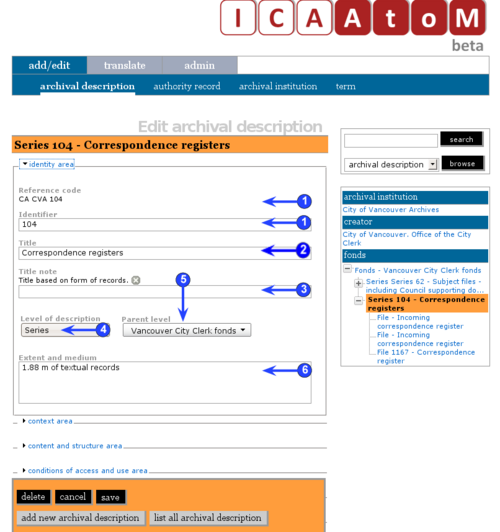ISAD
Jump to navigation
Jump to search
Please note that ICA-AtoM is no longer actively supported by Artefactual Systems.
Visit https://www.accesstomemory.org for information about AtoM, the currently supported version.
Archival description: Identity area
Main Page > (UM) User manual > UM-3 Add / edit content > UM3.1 Add / edit archival descriptions > UM-3.1.4 Identity area
The identity area contains fields for conveying "essential information ... to identify the unit of description" (ISAD(G) I.11).
1. Reference code
- For unique identification, the reference code may contain any or all of the following elements:
- "the country code in accordance with the latest version of ISO 3166 Codes for the representation of names of countries;
- the repository code in accordance with the national repository code standard or other unique location identifier;
- a specific local reference code, control number, or other unique identifier.
- All three elements must be present for the purpose of information exchange at the international level." (ISAD(G) 3.1.1)
- A country code and repository code will automatically be included in the reference code whenever the highest-level archival description is linked to an archival institution (see UM-3.1.5 Context area). The archival institution description must have the following fields filled out in order for this to happen: the identifier field in the identity area (see UM-3.3.4 Identity area) and the country field in the contact area (see UM-3.3.5 Contact area).
- Information entered into the identifier field at lower levels of description will appear as part of the reference code when the archival description is saved and displayed.
- Each child archival description will inherit reference code data entered at the parent levels of description.
- Note that the reference code will not be displayed in either the edit screen or view screen for any description that does not have its own identifier.
2. Title
- "Provide either a formal title or a concise supplied title in accordance with the rules of multilevel description and national conventions.
- If appropriate, abridge a long formal title, but only if this can be done without loss of essential information.
- For supplied titles, at the higher level, include the name of the creator of the records. At lower levels one may include, for example, the name of the author of the document and a term indicating the form of the material comprising the unit of description and, where appropriate, a phrase reflecting function, activity, subject, location, or theme.
- Distinguish between formal and supplied titles according to national or language conventions." (ISAD(G) 3.1.2)
3. Title note
- This is a multi-value field for registering and displaying the notes relating to the title of the unit of description.
- Enter the note; when you click the save button in the button block the note will be registered and will now appear in the list above the data entry fields.
- There is no limit to the number of title notes you can add, but as of the current version of ICA-AtoM (v1.0 beta) you can only register them one at a time: i.e. enter the data, click the save button and repeat for each additional note.
- To delete a title note, click the delete icon.
- Title notes also appear with other notes in the notes area.
4. Level of description
- "Record the level of this unit of description." (ISAD(G) 3.1.4)
- ICA-AtoM ships with a default value list of levels of description; this can customized by editors and administrators.
5. Parent level:
- Select the unit immediately above the current one in the hierarchy of arrangement (the parent record).
- Leave blank if the current unit represents the highest level of arrangement (e.g. a fonds).
6. Extent and medium
- "Record the extent of the unit of description by giving the number of physical or logical units in arabic numerals and the unit of measurement. Give the specific medium (media) of the unit of description.
- Alternatively, give the linear shelf space or cubic storage space of the unit of description. If the statement of extent for a unit of description is given in linear terms and additional information is desirable, add the additional information in parentheses." (ISAD(G) 3.1.5)
7. Note that the ISAD(G) Dates element (ISAD(G) 3.1.3) is implemented by ICA-AtoM in the context area, where dates are linked to a creator in a creation event.
